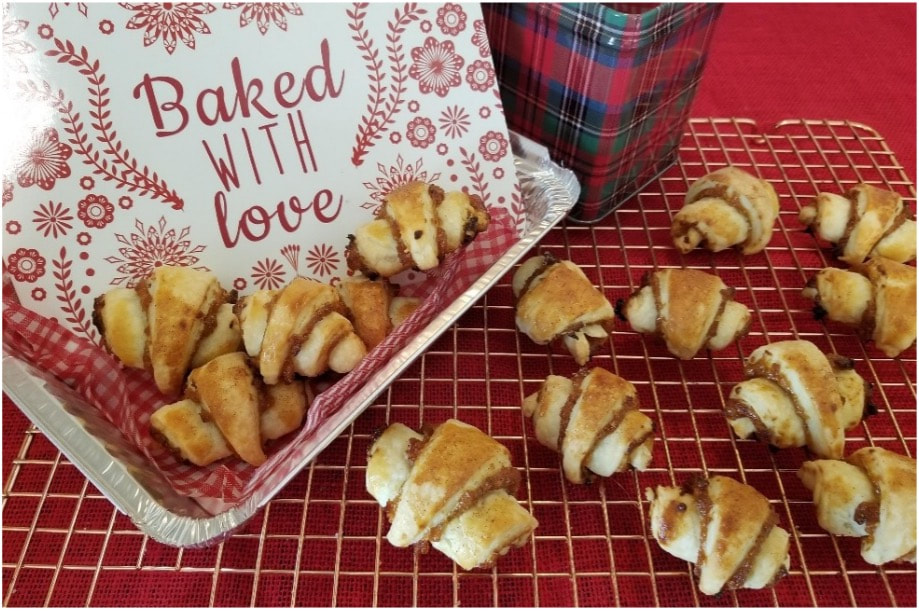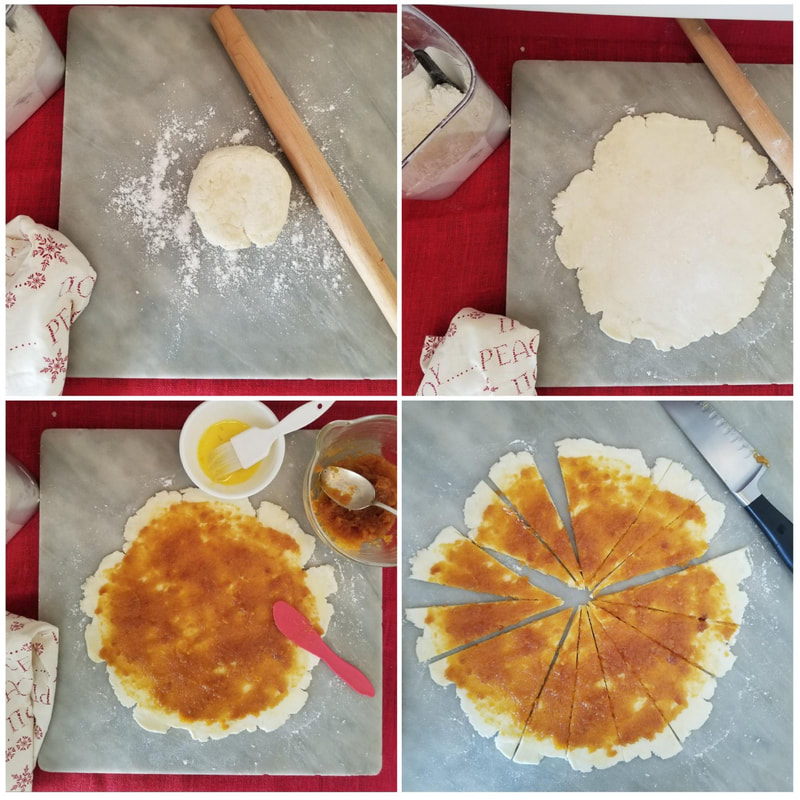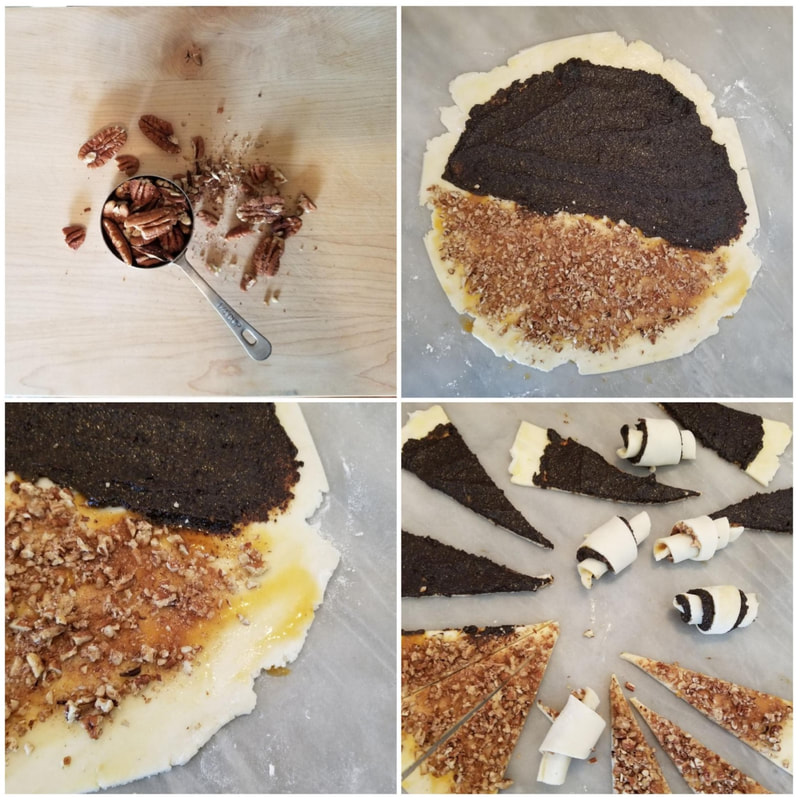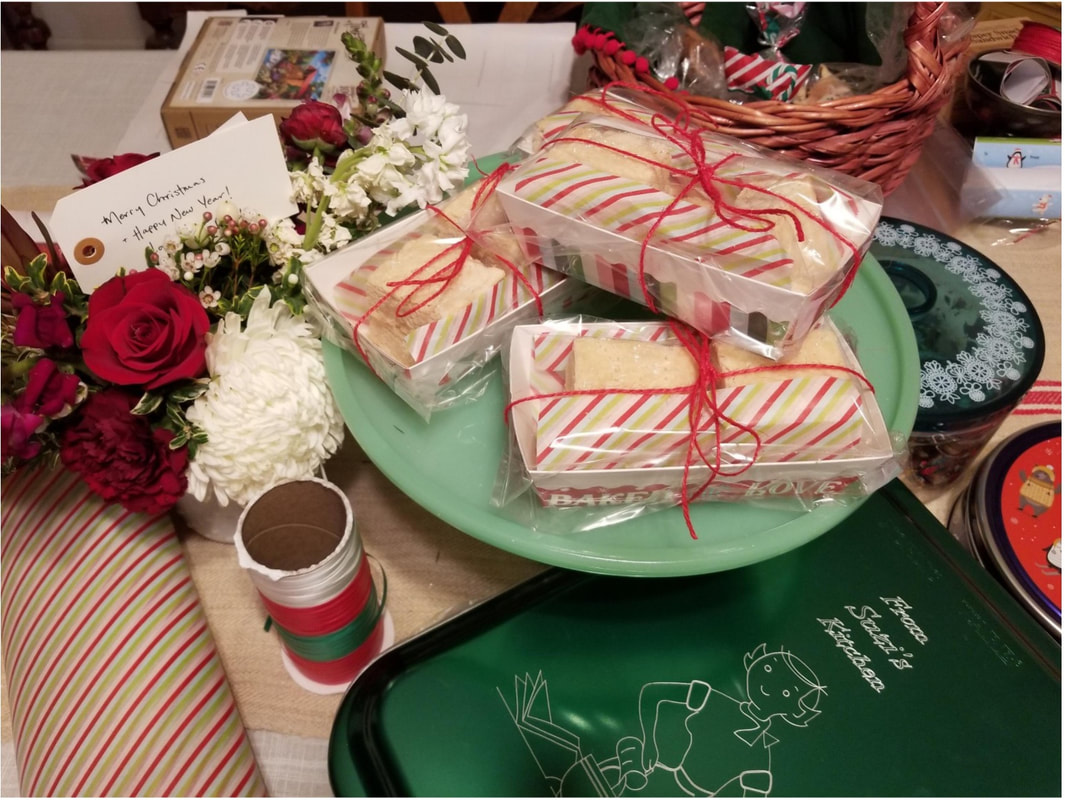After much experimentation, butter cookies in the European tradition have dominated my holiday cookie list. Spritz cookies, shortbread, sugar cookies, Russian tea cakes, aka Mexican wedding cakes, all fall in this category. Varied with nuts, fillings, preserves, fruit peels, almond paste and the like, they are all in the butter cookie family. That means they have the same short and crisp texture so will play nicely together in your cookie gift tin or on your gift plate.
In Rose’s December 2017 Tea Travels blog, she gifts readers with a list of her favorite holiday cookies and some excellent recipes. I write about cookies in my December 2018 Cakes and Tea blog, adding some general cookie-baking advice, baking pantry ingredients, and packaging ideas. Like most folks, here at My Tea Planner, we love cookies, preferably with an accompanying cup of hot tea. A search from our home page brings up dozens of cookie recipes, many suitable for holiday baking.
This year, I’ve added an Eastern European classic cookie slash pastry with so many traditional fillings, rugelach. A staple in bakeries and Jewish delis, rugelach is the ultra rich and flaky rolled-like-a-crescent roll cookie that sports filling of grounds nuts, cinnamon sugar, dried fruit purees, or preserves. The dough includes cream cheese as well as lots of butter, making a luscious background for the various fillings.
Larger and heftier than typical cookies, rugelach are almost pastry-like in their density and delectableness. You may be tempted to eat more than one in a sitting because they are so heavenly, but it is probably best to stop at one, just saying. The recipe makes exactly 32 pieces making it easy to plan for gifting.
Rugelach
Flaky, luscious rugelach will wow anyone with a sweet tooth. Fillable with the flavors of your choice, rugelach is easily customizable to your taste. If you are in the mood to spend a cozy afternoon in the warm kitchen, choose one of the homemade fillings below or if you just need to get it done, you can simply fill with a thickish jam or sprinkle with cinnamon sugar, or both. Solo brand fillings come in several flavors and are found in the baking aisle of most grocery stores and are a delicious shortcut. Whichever you choose, you will be so glad you made rugelach to eat and share this holiday season.
Special equipment: large mixing bowl, wooden spoon, plastic wrap or bee’s waxed cloth, small bowl, fork, rolling pin, pastry brush, large, sharp knife or pizza cutter, 2 baking sheets lined with parchment or silicone mat, cooling rack
Makes 32
Preheat oven in step #3 to 325 degrees F
- 1 cup (2 sticks) butter, at room temperature
- 8 ounces cream cheese, at room temperature
- 2 cups flour, plus more for rolling out dough
- ½ teaspoon salt
- 1 egg beaten with ½ teaspoon of water (egg wash*)
- Filling of choice
- Cinnamon sugar
- Powdered sugar
- In large mixing bowl, stir together butter and cream cheese until just combined. Add flour and salt and mix together just until dough looks mostly uniform; do not overmix.
- Pat dough into 2 equal sized disks and flatten to about 5 inches in diameter. Wrap in plastic wrap or bee’s waxed cloth and chill at least 4 hours or overnight. Use within 2 days. When ready to use, let dough rest on work surface for 20-30 minutes.
- Preheat oven to 325 degrees F. In small bowl, mix egg and water together for egg wash, set aside. On heavily floured surface, roll out 1 disk to a circle about 12 inches in diameter or 1/8 inch thick. Trim edges if desired; I just tucked the ragged edges in when I rolled up the crescents.
- Brush egg wash about 1 inch around outer edge of circle. Spread filling of choice to within 1 inch of edge. Cut circle into 12 wedges, like a pizza. Starting from wide edge, roll up wedge, tucking point under roll. Place at least 1 inch apart on prepared baking sheet. Brush tops with egg wash. Sprinkle with cinnamon sugar, if desired. Repeat with remaining dough.
- Bake for 35 to 40 minutes, rotating pans from back to front and changing pans from top to bottom halfway through baking time. Tops should be well-browned, quite a bit darker than most butter cookies. Transfer to rack to cool. Sift powdered sugar over tops, if desired. Store in tightly sealed containers and eat or give promptly. Cookies freeze well, if tightly wrapped.
Below: Rolling out the dough, egg washing the outer edge, spreading with apricot filling, cutting the circle into 16 wedges. Note I am using one spoon for my jar of filling and a different tool, a silicone spreader, to avoid cross contamination. *
Poppy Seed-Prune Filling
For this filling, I merged two traditional fillings, poppy seed filling and prune filling. Neither are all that widely popular these days, but that does not deter us from seeking them out and baking with these distinct flavors. I love both poppy seed and prune and they are really tasty together. I will add poppy seeds to a recipe at the least provocation, and finding a prune Danish to sample is a wonderful culinary quest. Both prunes and poppy seeds thicken nicely when cooked so produce a filling with a thick consistency and will not seep out of our rugelach.
Special equipment: small saucepan, wooden spoon, silicone spatula, food processor, coffee grinder, air-tight container such as a pint canning jar
Makes about 1 ¼ cups filling
- ½ cup pitted prunes
- 3 tablespoons brandy, rum, or water
- 2 tablespoons sugar
- ½ cup poppy seeds
- ½ cup milk
- 1/3 cup sugar
- In small saucepan, combine prunes, brandy, and 2 tablespoons sugar. Cook over medium-low heat, stirring often, until prunes are softened and liquid is almost evaporated, about 6-8 minutes. Scrape prunes and any liquid into food processor bowl, set aside saucepan for heating the poppy seed mixture, no need to clean out pan.
- In coffee grinder, grind poppy seeds in batches, if necessary, until it is coarsely ground but not gummy. Place ground poppy seeds in the reserved saucepan. Add milk and 1/3 cup sugar and stir together.
- Cook over medium-low heat, stirring often, until mixture thickens, about 3 minutes. Remove from heat and stir to cool for about a minute.
- Scrape poppy seed mixture into food processor bowl with prunes and process until smooth, scraping down sides as needed. Store filling in air-tight container (I use a pint canning jar) and store in fridge, up to a week. Filling may be used between cake layers, if thinned down to spreadable consistency with brandy or water.
I love all things apricot, and a good apricot filling is among the best flavors out there. However, I’ve noticed a dispiriting trend the last few years: the best dried apricots, the dark orange, very dry-looking dried apricots, “slab” apricots are getting harder to find. I might be a little too picky about my apricots because I was born in The Valley of the Heart’s Delight, now unfortunately known as Silicon Valley, ugh. My grandmother Lady’s subdivision in Milpitas was built in a former apricot orchard and they left one apricot tree in the backyard, so we kids feasted on the best apricots right off the tree each spring. After moving to the coast, we went to Hollister to get our apricots to make jam.
In recent history, Trader Joe’s for years carried slab apricots, but they’ve since disappeared from the shelves. In their place, hard-though-puffy, under-ripe dried apricots sometimes labeled Turkish apricots, have been showing up as the only choice. I tested the apricot filling recipe with these imposters, and they never became softer, no matter how long the apricots were boiled in the syrup. It tasted okay but when pureed, lacked the velvety texture of better dried apricots. Looking closely at the photos of the spread-out filling, you can see that it is still chunky though food processed longer than normal. If you go to the farmer’s market or go to the farm for your summer fresh apricots, definitely buy dried apricots from the farmer, if they offer them. I get fresh and dried apricots from Bremmer’s Farm in Arbuckle, California, (they are on yelp and facebook) during the short fresh apricot season, two or three weeks around Father’s Day each year. This year, I got my lug of over-ripe apricots to make into jam but neglected to stock up on their dried apricots. Look for the precious slab apricots at fancier markets or online, if you are shopping after apricot season is over. Let’s cross our fingers that Trader Joe’s will shape up and get them back on the shelves. I’m also going to make a plea to my cooks and bakers to make fresh apricot jam, as the flavor is incomparable to store bought. You’ll be so happy in winter when you make the effort in June!
In doing my apricot research I stumbled across a fantastic website For the Love of Apricots, written by Lisa Newman. Her blog post about The Valley of the Heart’s Delight will fill you in on all things old Santa Clara Valley and of course, all things apricot. She even has a map of west coast apricot orchards where folks can buy apricots in season. She grew up in the Saratoga foothills, literally watching the valley turn from acres of fruit orchards to ugly buildings. She is a champion of local agriculture and actually wrote a whole book on apricot recipes. I tried to purchase a copy but ye ole PayPal is not cooperating at this time. As suggested, I will try again. Lisa, we salute you!
Special equipment: medium saucepan or 1 quart microwave-safe bowl, wooden spoon, silicone spatula, food processor, air-tight container such as a pint canning jar
Makes about 1 1/2 cups filling
- 1 cup (packed) dried apricots, preferably “slab” apricots, if you can find them
- ½ cup water
- ½ cup sugar
-
- In medium saucepan or microwave-safe bowl, stir together apricots, water, and sugar.
- Cook over medium heat or microwave at full power, stirring occasionally, until apricots are rehydrated and puffy and most of the liquid has evaporated, about 10 to 15 minutes. Remove from heat and let cool for about 5 minutes.
- Scape apricots and any liquid into food processor and process until smooth, scraping down sides as needed. Store filling in air-tight container (I use a pint canning jar) and store in fridge, up to a week. Filling may be used between cake layers, if thinned down to spreadable consistency with brandy or water.
In her excellent cookbook, The All-American Cookie Book, award-winning author Nancy Baggett celebrates not only familiar cookie recipes but utilizes native American ingredients such as cranberries. She created a holiday ice box cookie recipe (Cranberry Cherry Icebox Ribbons) whose filling is a delicious and eye-catching scarlet-hued mix of dried cranberries and cherry jam. The filling is the perfect non-runny consistency to fill thumbprints, layer with a vanilla dough as Nancy does, or use in rugelach. I highly recommend The All-American Cookie Book, first published in 2001. Use our favorite cherry jam, Bon Maman; it is really the best on the market and is widely available in grocery stores.
Special equipment: food processor, small saucepan, wooden spoon, silicone scaper, air-tight container such as a pint canning jar
Makes about 1 cup
Per Nancy:
- Generous ¾ cup of dried, sweetened cranberries, about 3 ounces
- Generous 1/3 cup cherry jam or preserves
- 1 ½ tablespoons sugar
- ½ teaspoon almond extract
In a food processor, process the cranberries, jam or preserves, and sugar until coarsely pureed, Transfer the mixture to a small, heavy saucepan. Cook over medium-high heat, stirring occasionally, until it just comes to a boil; immediately remove from the heat. Let stand until cooled slightly. Stir in the almond extract. Cover and refrigerate for at least one hour, or until well chilled, or freeze for 30 minutes to speed chilling. (The filling may be refrigerated for up to 4 days; return to room temperature and stir before using.)
Variation: replace dried cranberries with dried cherries for an all-cherry filling.
*A note to avoid cross contamination with egg wash and fillings
If you plan to keep your leftover filling in the fridge for later use, use two separate utensils: one spoon for dolloping the filling into the center of the rolled-out dough, and another spoon or spreader for spreading out the filling where it will come into contact with the egg wash. In other words, you want to keep any egg out of your filling.
Holiday Cookie Bibliography
The following cookbooks are my tried-and-true holiday cookie recipe favorites. Of course, I am seasonally seduced by shiny new recipes in magazines and on the internet but after many years of cookie baking, I return again and again to these books. If I had to pick only one to take to the snowed-in cabin with a great oven, I’d take the Sunset magazine paperback book compilation, Sunset Cookies, but I’d most likely smuggle in the other four cookbook, too. The older ones can be found in second-hand bookstores and most likely can all be found online.
- Baggett, Nancy. The All-American Cookie Book. Houghton Mifflin Company, 2001
- Clark, David E. ed. Sunset Cookies. Lane Publishing, 1986
- Greenspan, Dorie. Baking with Julia. William Morrow and Company, 1996
- Stewart, Martha. Martha Stewart’s Cookies. Clarkson Potter, 2008
- Walter, Carole. Great Cookies. Clarkson Potter, 2003
nn







